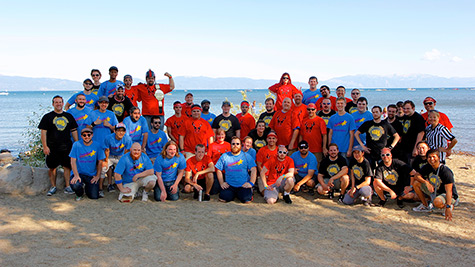The untamed wilderness is the last place you would think to find a game development studio. Yet that is exactly where Another Castle’s Best Newcomer Studio, Developer, or Publisher of 2013 winner Hinterland can be found. Established in 2012 in Northern Vancouver Island, a team of seasoned veterans formed to create captivating games they could be proud of. With everyone having 10-15 years of experience in the AAA industry, they decided to break free and make something personal.
Beginning Anew
Raphael Van Lierop, Founder and Creative Director, worked in various positions during his 13 years in the industry, but he felt it was time to do something different. It wasn’t because he wanted to “be an indie,” but he did want to work in a studio with a foundation he could believe in. “I wanted to be able to work on something that felt more personal, more artistic, and more of an expression of individual thinking,” says Van Lierop. “That’s hard to do in the established industry where teams and budgets are so big - we all know those dynamics really work against creating original games that are trying to push against the mainstream.”
Other veterans felt the same way as Van Lierop and joined him on this new path. “We’d all pretty much hit that same point in our careers, where we still wanted to work on great games with great collaborators, but wanted to do it under our own terms,” says Van Lierop. “Hinterland is about being independent.”
Due to all the experience the team has, it took almost no time for them to get down to business. As with all studios starting out, they had their share of challenges, but they got through by evaluating the situation and making the best decision that could lead them forward. “This is one of the huge benefits of working with a small team – you can turn on a dime and you don’t have to lose time waiting for someone to give you the greenlight to make a major change or whatever,” says Van Lierop. “You just do it.”
Working Simply
Hinterland was established to enable the team to create games they wanted without having to sacrifice themselves to do it. “So really, I had to found Hinterland to make the kinds of games I wanted to make in a more ‘humane’ way, which didn’t require people to uproot their families and lives to be able to do good work,” says Van Lierop. To be able to do this, they incorporate many online tools to keep things running smoothly, such as Basecamp, Skype, and Dropbox.
The day starts off simply: discuss what needs to be done and then work to complete it. Van Lierop determines the project direction and works with the team to distribute it into different areas. As pros, they are good at working together. “We test theories, try to evaluate – honestly and objectively – the strength of the ideas or implementation and make the changes we need to improve things,” says Van Lierop. “We’re not overly precious about ideas, which isn’t to say we don’t have a vision, we’re just all experienced enough to know that ideas are meaningless without a strong execution behind them.”
When starting the studio, it wasn’t about going indie, and it isn’t like they are thinking of trying to incorporate AAA into indie development. It just happens. “You don’t stop to think about how you’re breathing, you just breathe,” says Van Lierop. “We just make games.” Rather than think of themselves as indie, Hinterland is independent, and Van Lierop believes there is a difference. “It’s not like, here’s my triple-A handbook, and here’s my ‘indie’ handbook, and I flip between depending on the game,” says Van Lierop. “I think there’s this popular notion that if you come from the triple-A space, you don’t know how to make an ‘indie’ game – like somehow your ability to think independently atrophies because you worked within an established studio.” Yet scope and agility are the only real differences between AAA and indie projects, he believes. Also, the lack of a publisher limits what they can do, but they still push forward with their mission of creating meaningful games.
Creating Thought-Provoking Games
The public often does not take games seriously. Van Lierop wants to change the view into games being “a mature medium for delivering a variety of meaningful experiences that touch people on multiple levels.” Years from now, he wants to feel proud of the work he’s done. “It’s not about making a ‘product’ or a ‘best-seller’ or any of that stuff,” says Van Lierop. “It’s about creating something and knowing that other people thought it was good enough they were willing to assign a value for it, both in terms of their time and money.”
To do this requires making good choices about content, tone, and mechanics, according to Van Lierop, and investing yourself into creating a new kind of experience. They hope to accomplish this with their first title, The Long Dark. Coming from a concept Van Lierop had considered for years and enhanced by the team, they wanted players to have a fascinating experience. Without a combat mechanic, they hoped to immerse players through tone and content. Van Lierop says, “In terms of tone and content, a lot of this comes down to things like world design, art direction, narrative, etc., and for that, I think our approach is pretty simple – respect our craft, respect our audience, and try to do something that would be worthy of any medium, so that people don’t just say ‘Wow, that was a pretty meaningful experience *for a game*,’ they say, ‘that was a meaningful experience for *any medium*.’”
To realize the game, they decided to crowd-fund using Kickstarter, and believed it was a great experience. “We’ve never really been in a position to talk about a game so early in development, so it was simultaneously energizing and scary as hell,” says Van Lierop. The game was successfully funded on October 16, 2013, raising more than $50,000 past their initial goal. But for the team, it wasn’t just about the funds. “For us, the Kickstarter was almost more about announcing the game and studio, staking a claim on the concept, starting the process of building the all-important community, and basically saying ‘We’re here. Watch this space.’”
The team is excited to produce their first title, and are overcoming many challenges to make it a tribute to their mission, but Van Lierop thinks meeting both the team’s and players’ expectations is the most challenging. “What we want players to experience is really simple: something that impacts them, makes them think long after they’ve finished playing, and is unlike anything they’ve played before.”
Hinterland hopes to provide years of thought-provoking entertainment with the help of a dedicated, supportive community. But for now, the team is concentrating on The Long Dark, hoping to release it October 2014. Fundraising for stretch goals are continuing on the game’s website. Stay updated by following the team on Twitter and Facebook.












